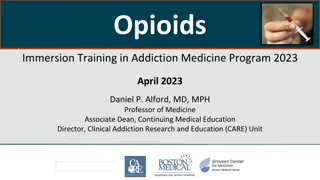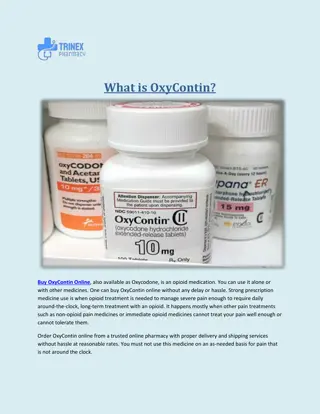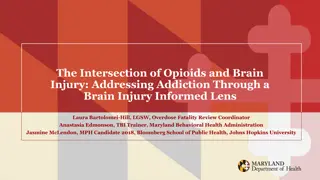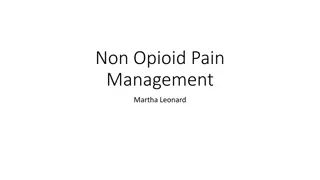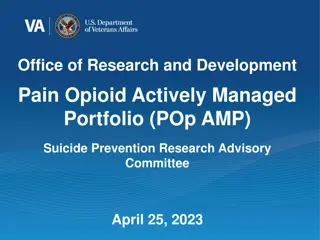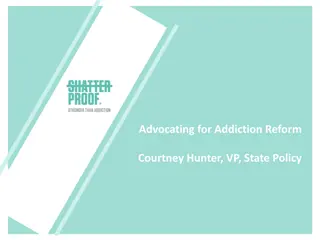Update on Opioid Addiction Task Force with State Health Officer Ali Harrist - July 2019
Review of data on overdose deaths, indicators of opioid use, and special populations by the Opioid Addiction Task Force led by Ali Harrist, MD, PhD. The update covers activities of the Public Health Division, Behavioral Health Division, and Vital Statistics Services in Wyoming. Data sources include Wyoming Vital Statistics Service and CDC Wonder, highlighting trends and prevalence of prescription pain reliever misuse and unauthorized medication use.
Download Presentation

Please find below an Image/Link to download the presentation.
The content on the website is provided AS IS for your information and personal use only. It may not be sold, licensed, or shared on other websites without obtaining consent from the author.If you encounter any issues during the download, it is possible that the publisher has removed the file from their server.
You are allowed to download the files provided on this website for personal or commercial use, subject to the condition that they are used lawfully. All files are the property of their respective owners.
The content on the website is provided AS IS for your information and personal use only. It may not be sold, licensed, or shared on other websites without obtaining consent from the author.
E N D
Presentation Transcript
Update to the Opioid Addiction Task Force Ali Harrist MD, PhD State Health Officer & State Epidemiologist 30 July 2019
Agenda 2 Data Review Overdose deaths Indicators of use Special populations WDH Activities Public Health Division (PHD) Behavioral Health Division (BHD) Vital Statistics Services (VSS)
Source: WY Vital Statistics Service - Death Certificates; CDC Wonder. Error bars represent 95% confidence intervals. Underlying Cause ICD10 Codes: X40-X44, X60-X64, X85, Y10-Y14 Contributing ICD10 Cause Codes: T40.0 T40.1 T40.2 T40.3 T40.4 3
Source: WY Vital Statistics Service - Death Certificates Error Bars represent 95% confidence intervals * Rates not reliable due to small numbers 4
Source: WY Vital Statistics Service - Death Certificates Years 2016-2018 5
2014-2018 combined years, source: WY Vital Statistics Service - Death Certificates 6
2008-2018 combined years, source: WY Vital Statistics Service - Death Certificates 7
Self-reported Prevalence of Prescription Pain Reliever Misuse in the Past Year Among Civilians 12 and Older - Wyoming and the United States, 2015-2017 Respondents Percent Source: National Survey on Drug Use and Health. Error bars represent 95% confidence intervals. 8
Self-reported Use of Prescription Medications that Were Not Prescribed in the Past 30 Days Among Middle and High School Students - Wyoming, 2018 Respondents Percent Source: Wyoming Prevention Needs Assessment (Wyoming Survey and Analysis Center). 9
Number of Substance Abuse Treatment Admissions Where Opioids are the Primary Substance Used - Wyoming, 2014-2018 Number of Admissions Source: Treatment Episode Data Set (SAMHSA) 10
Use of Prescription Pain Relievers in the Month Before Pregnancy Among Women Who Have Recently Given Birth - Wyoming, 2016-2017 Respondents Percent Source: Wyoming Pregnancy Risk Assessment Monitoring System (PRAMS) Error Bars represent 95% confidence intervals Note: Receiving funding from CDC to ask supplemental questions about opioid use during pregnancy 11
Infants Diagnosed with Neonatal Abstinence Syndrome (NAS) per 1,000 Live Birth and Neonatal Hospitalizations - Wyoming, 2015-2018 (Preliminary Data) Number of NAS Diagnoses Per 1,000 Hospitalizations 3.98 Source: Wyoming Hospital Claims Data 12
Bloodborne Pathogens and Intravenous Drug Use 13 Year Percent of Newly Diagnosed Hepatitis C Cases 36 Years Reporting Any Intravenous Drug Use 28% (27/97) 46% (52/114) 59% (69/116) 70% (78*/111) 2015 2016 2017 2018 * 45/78 reported using heroin
Public Health Division - Funding 14 Strategic Prevention Framework-Partnerships for Success (SPF-PFS) Federal funding from the Substance Abuse and Mental Health Services Administration (SAMHSA) $1,648,188 per year for 5 years (2015-2020) Goals: Prevent underage drinking among persons aged 12-20, prevent prescription drug misuse among persons aged 12-25, strengthen prevention capacity and infrastructure at the community level Grant to Prevent Prescription Drug/Opioid Overdose-Related Deaths (PDO) Federal funding from the Substance Abuse and Mental Health Services Administration (SAMHSA) $1,000,000 per year for 5 years (2016-2021) Goal: Prevent overdose due to prescription drugs/opioids through distribution of naloxone to first responders and training on its use
Public Health Division - Funding 15 Opioid Overdose Crisis Cooperative Agreement Federal funding from the Centers for Disease Control and Prevention (CDC) $1,043,925 to be spent from Sept 1, 2018 through Nov 30, 2019 Goals: Strengthen incident management for early crisis response, strengthen jurisdictional recovery, strengthen biosurveillance, strengthen information management, strengthen countermeasures and mitigation, strengthen surge management
Public Health Division - Potential Future Funding 16 Overdose Data to Action Federal funding from the Centers for Disease Control and Prevention (CDC) Wyoming did not apply for the 2019-2021 cycle Expect new opportunity in 2022 Substance Use-Disorder Prevention that Promotes Opioid Recovery and Treatment (SUPPORT) for Patients and Communities Act - potential funding opportunities: First responder training Improved fentanyl and other synthetic opioid detection Comprehensive opioid recovery centers Trauma support services and mental health care for children and youth in educational settings Loan repayment for substance use disorder treatment workforce
Public Health Division - Naloxone 17 Activity from November 27, 2017 through June 30, 2019: 1,335 doses of Narcan distributed 1,243 individuals trained through WDH in identification of and response to opiate related overdoses 10 reports of naloxone administration on the WDH website and 9 additional through opirescue.com ~34 reports per month of naloxone administration by EMS in WATRS Revised rules to include the use of naloxone in the Emergency Medical Responder (EMR) and Emergency Medical Technician (EMT) scopes of practice Future opportunities - Open distribution to individuals and those leaving incarceration
Public Health Division Drug Disposal 18 Purchased and distributed 38 drug disposal drop boxes and 18 drug incinerators to local police departments and sheriff s offices Partnering with several local pharmacies to add more drop box locations Distributed Deterra drug deactivation bags throughout Wyoming through the community coalitions Locations include pharmacies, nursing homes, individuals, law enforcement, faith- based locations
Public Health Division Training and Education 19 Free online opioid overdose recognition and response training at getnaloxonenow.org Purchased access to training data for tracking purposes Contract with the Wyoming Association of Sheriffs and Chiefs of Police (WASCOP) to provide law enforcement opioid overdose training and education Maternal and Child Health Unit and Wyoming Perinatal Quality Collaborative will co-host a fall 2019 health care provider training on safe prescribing of opioids for pregnancy and postpartum women Released a Request for Applications in July 2019 for the Opioid Response Quality Improvement Grant Program for Wyoming Hospitals. The grant program will provide up to $10,000 per awarded hospital to implement quality-improvement strategies or projects related to opioid use during pregnancy and neonatal abstinence syndrome.
Public Health Division Media and Outreach 20 Media campaign with the Governor s Council for Impaired Driving for public education on the risks of drugged driving Contracting with a media purchasing firm to distribute the Centers for Disease Control and Prevention s Rx Awareness campaign throughout Wyoming Aims to increase awareness and knowledge about the risks of prescription opioids and stop inappropriate use Collaborating with the Wyoming Rx Abuse Stakeholders (RAS) on the They Didn t Know media campaign
Public Health Division Surveillance and Epidemiology 21 Hired dedicated Substance Abuse Prevention Epidemiologist Implementing fentanyl and fentanyl analog screening and quantification in clinical samples in the Wyoming Public Health Laboratory Survey of hospitals to understand injury coding Contract in process with University of Wyoming s Wyoming Geographic Information Science Center (WYGISC) to create a Geographic Information System-based opioid dashboard Locations of resources Opioid overdose death heat maps
Public Health Division Prevention of Bloodborne Pathogen Transmission 22 Targeted messaging encouraging people who inject drugs to get tested and educating about resources for testing As of 2017, including questions about drug use as part of routine follow-up for persons who test positive for reportable sexually transmitted infections Refer those who use IV drugs for Hepatitis C and HIV testing Provide information about treatment resources Provide syringe disposal containers to communities through public health nursing
Public Health Division - Wyoming Opioid Abuse Strategic Plan 23 In collaboration with the Centers for Disease Control and Prevention (CDC) and the Wyoming Rx Abuse Stakeholders Strategic planning session held in August, 2018 Contract in process for the written plan One goal is to prepare for future CDC funding opportunities
Behavioral Health Division - State Opioid Response (SOR) Grant 24 Project period: September 30, 2018 to September 29, 2020 Total funding: $10,126,579.00 Goal: Prevent opioid epidemic experienced in other states using three strategies: Provide access to Medication Assisted Treatment (MAT) Increase access for more people through integrated health care and partnerships with criminal justice Reduce opioid overdose-related deaths through treatment and recovery services for opioid use disorder (OUD)
Behavioral Health Division - State Opioid Response (SOR) Grant 25 Medication Assisted Treatment (includes care coordination, case management, counseling, FDA-approved medication, prescriber services, medication management, peer specialist services, and recovery supports and may include telehealth and the use of mobile applications) Subrecipient Counties Served Central Wyoming Counseling Natrona County High Country Behavioral Health Lincoln, Sublette, Uinta Intermountain Health Center Park, Washakie Northern Wyoming Mental Health Crook, Johnson, Sheridan, Weston Southwest Counseling Service Sweetwater Peak Wellness Center and Community Action of Laramie County Laramie
Behavioral Health Division - State Opioid Response (SOR) Grant 26 Healthcare Coordination and MAT Cody Regional Health Cedar Mountain Center MAT and partnerships between hospitals, community substance abuse treatment providers and pharmacies in the Basin Region Wyoming Institute of Population Health (Cheyenne Regional Medical Center) Practice improvement initiative to address opioid prescribing practices, community coordination and stigma reduction, and increase the use of Screening, Brief Intervention, and Referral to Treatment (SBIRT) among hospital-affiliated practitioners
Behavioral Health Division - State Opioid Response (SOR) Grant 27 Court Supervised Treatment Implement policies and practices to engage and retain CST participants with OUD in MAT services Corizon Health/Gateway Foundation/Wyoming Department of Corrections GEO/Gateway Foundation/Wyoming Department of Corrections Albany County Court Supervised Treatment Program Sweetwater County Court Supervised Treatment Program
Behavioral Health Division - State Opioid Response (SOR) Grant 28 Corrections Bridge Pilot Warm hand-offs between Department of Corrections and their contractors to local MAT providers for people with OUD released from prison Provide long-acting medication (e.g. naltrexone) Ongoing medication support Recovery supports
Behavioral Health Division - State Opioid Response (SOR) Grant 29 Additional Grant Activities Contracting underway for State Opioid Coordinator Compile database of all federal, state, local opioid funding efforts Wyoming Survey and Analysis Center Grant and program evaluation Wind River Indian Reservation Needs assessment completed June 30, 2019 Recommendations for funding for treatment services and recovery supports Planning underway to contract for services
Behavioral Health Division - State Opioid Response (SOR) Grant 30 Successes Increasing capacity for treatment and recovery services Expanding partnerships with health care entities and corrections Increasing numbers of waiver providers, i.e., doctors, physician assistants, and nurse practitioners prescribing MAT Increasing number of persons served, amount of services delivered, and retention in treatment Expanding training and education for those on the front lines addressing community needs impacted by opioid addiction
Behavioral Health Division - State Opioid Response (SOR) Grant 31 Gaps and Challenges Ongoing needs to recruit and retain MAT prescribers and clinical treatment staff Overcoming stigma of those in need of addiction treatment Federal funding is highly prescriptive for individuals with OUD and can not be used to address Wyoming s other addiction needs Funding is time-limited without expectation of future funding opportunities
Vital Statistics Services Coroners Database Application 32 Currently no standardized case management system among Coroners Using PDO, NVDRS, and opioid crisis grant funding, WDH is developing a case management application for coroners Direct interface with vital records system Integration of historic coroner records Potential links to law enforcement systems, Board of Pharmacy Goal is to improve accuracy and timeliness of coroner reports and death certificates, improve ability to analyze death data One county using the live system now, 4 others preparing
33 Thank you alexia.harrist1@wyo.gov 307-777-7716


